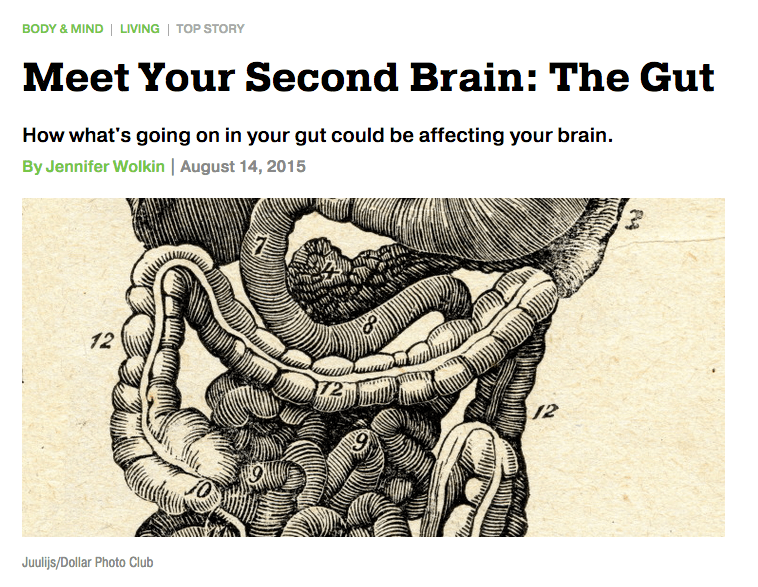
by Jennifer Wolkin | Aug 17, 2015 | Brain Health, Wellness
This blog post originally appeared on Mindful.Org

Most of us can relate to the experience of having butterflies in our stomach, or to a visceral gut-wrenching feeling, and how often are we told not to ignore our “gut-instinct” or “gut-feeling” when making a decision.
Even from our simple slang, it’s clear just how symbolically connected the gut is to our emotions. Now, there’s tangible proof to support these popular metaphors.
We all have a microbiome, and they are as unique as our neural pathways
Research has shown that the body is actually composed of more bacteria than cells. We are more bug than human! Collectively, these trillions of bacteria are called the microbiome. Most of those bacteria reside in our gut, sometimes referred to as the gut microbiota, and they play multiple roles in our overall health.
The gut is no longer seen as an entity with the sole purpose of helping with all aspects of digestion. It’s also being considered as a key player in regulating inflammation and immunity.
A healthy gut consists of different iterations of bacteria for different people, and this diversity maintains wellness. A shift away from “normal” gut microbiota diversity is called dysbiosis, and dysbiosis may contribute to disease. In light of this, the microbiome has become the focus of much research attention as a new way of understanding autoimmune, gastrointestinal, and even brain disorders.
The benefit of a healthy gut is illustrated most effectively during early development. Research has indicated just how sensitive a fetus is to any changes in a mother’s microbiotic makeup, so much so that it can alter the way a baby’s brain develops. If a baby is born via cesarean section, it misses an opportunity to ingest the mother’s bacteria as it travels down the vaginal canal. Studies show that those born via c-section have to work to regain the same diversity in their microbiome as those born vaginally. Throughout our lives, our microbiome continues to be a vulnerable entity, and as we are exposed to stress, toxins, chemicals, certain diets, and even exercise, our microbiome fluctuates for better or worse.
The gut as second brain
Our gut microbiota play a vital role in our physical and psychological health via its own neural network: the enteric nervous system (ENS), a complex system of about 100 million nerves found in the lining of the gut.
The ENS is sometimes called the “second brain,” and it actually arises from the same tissues as our central nervous system (CNS) during fetal development. Therefore, it has many structural and chemical parallels to the brain.
Our ENS doesn’t wax philosophical or make executive decisions like the gray shiny mound in our skulls. Yet, in a miraculously orchestrated symphony of hormones, neurotransmitters, and electrical impulses through a pathway of nerves, both “brains” communicate back and forth. These pathways include and involve endocrine, immune, and neural pathways.
At this point in time, even though the research is inchoate and complex, it is clear that the brain and gut are so intimately connected that it sometimes seems like one system, not two.
Our emotions play a big role in functional gastrointestinal disorders
Given how closely the gut and brain interact, it has become clear that emotional and psychosocial factors can trigger symptoms in the gut. This is especially true in cases when the gut is acting up and there’s no obvious physical cause.
The functional gastrointestinal disorders (FGIDs) are a group of more than 20 chronic and hard to treat medical conditions of the gastrointestinal tract that constitute a large proportion of the presenting problems seen in clinical gastroenterology.
While FGID’s were once thought to be partly “in one’s head,” a more precise conceptualization of these difficulties posits that psychosocial factors influence the actual physiology of the gut, as well as the modulation of symptoms. In other words, psychological factors can literally impact upon physical factors, like the movement and contractions of the GI tract, causing, inflammation, pain, and other bowel symptoms.
Mental health impacts gut wellness
In light of this new understanding, it might be impossible to heal FGID’s without considering the impact of stress and emotion. Studies have shown that patients who tried psychologically based approaches had greater improvement in their symptoms compared with patients who received conventional medical treatment.
Along those lines, a new pilot study from Harvard University affiliates Benson-Henry Institute for Mind Body Medicine at Massachusetts General Hospital and Beth Israel Deaconess Medical Center found that meditation could have a significant impact for those with irritable bowel syndrome and inflammatory bowel disease. Forty-eight patients with either IBS or IBD took a 9-week session that included meditation training, and the results showed reduced pain, improved symptoms, stress reduction, and the change in expression of genes that contribute to inflammation.
Poor gut health can lead to neurological and neuropsychiatric disorders
Vice-versa, poor gut health has been implicated in neurological and neuropsychiatric disorders. Disturbances in gut health have been linked to multiple sclerosis, autistic spectrum disorders, and Parkinson’s disease. This is potentially related to pro-inflammatory states elicited by gut dysbiosis-microbial imbalance on or inside the body. Additional connections between age-related gut changes and Alzheimer’s disease have also been made.
Further, there is now research that is dubbing depression as an inflammatory disorder mediated by poor gut health. In fact, multiple animal studies have shown that manipulating the gut microbiota in some way can produce behaviors related to anxiety and depression. (Maes, Kubera, Leunis, Berk, J. Affective Disorders, 2012 and Berk, Williams, Jacka, BMC Med, 2013).
Our brain’s health, which will be discussed in more depth in a later blog post, is dependent on many lifestyle choices that mediate gut health; including most notably diet (i.e., reduction of excess sugar and refined carbohydrates) and pre and probiotic intake.
The brain-gut connection has treatment implications
We are now faced with the possibility of both prevention and treatment of neurological/neuropsychiatric difficulties via proper gut health. On the flip side, stress-reduction and other psychological treatments can help prevent and treat gastrointestinal disorders. This discovery can potentially lead to reduced morbidity, impairment, and chronic dependency on health care resources.
The most empowering aspect to the gut-brain connection is the understanding that many of our daily lifestyle choices play a role in mediating our overall wellness. This whole-body approach to healthcare and wellness continues to show its value in our longevity, well-being, and quality of life: that both physical and mental health go hand-in-hand.

by Jennifer Wolkin | Aug 9, 2015 | Brain Health, Mindfulness, Wellness
This blog post originally appeared, in an adapted form, on Mindful.Org

I don’t know about you, but I feel so much better when my environment is neat and organized. After a long day of work, coming home to a neat space is like coming home to myself. It is a refuge, truly, and I feel soothed.
 When I wake up in the morning, before the sun comes up, and stumble to my espresso machine, bleary eyed and still ridiculously tired, a neat space seems to beckon me to use my time in the way I so desire. I try to wake up early to practice mindfulness, set an intention for the day, and then either focus to finish patient notes from the day before, or write creatively…although I’d like this to happen more regularly than it does, I am gentle with myself when it doesn’t.
When I wake up in the morning, before the sun comes up, and stumble to my espresso machine, bleary eyed and still ridiculously tired, a neat space seems to beckon me to use my time in the way I so desire. I try to wake up early to practice mindfulness, set an intention for the day, and then either focus to finish patient notes from the day before, or write creatively…although I’d like this to happen more regularly than it does, I am gentle with myself when it doesn’t.
I do know, however, that there are certain ingredients that will immediately create an impasse for all that to manifest. That is waking up to a messy space. Waking up to a messy space becomes a metaphor for the brain fog and overwhelming feelings that begin to ensue. Decluttering is hard, but it is worth it. The effects impact your mind and body. Some of the behavioral work with my patient focuses on paced organization schedules as well as cognitive work regarding the “letting go” of the clutter that many of us create to protect ourselves. This idea is vast, and I will write a post about that in its entirety at a later time.
 My patients find that undoubtedly, as the cutter begins to lessen, they feel a clearing in their minds that they never thought was possible. This is a kind of outside-in decluttering. A physical clearing creates vast mind space. I recommend this extraordinary book to help you get started with the outside in process: “The life-changing magic of tidying up”.
My patients find that undoubtedly, as the cutter begins to lessen, they feel a clearing in their minds that they never thought was possible. This is a kind of outside-in decluttering. A physical clearing creates vast mind space. I recommend this extraordinary book to help you get started with the outside in process: “The life-changing magic of tidying up”.
Here’s the thing though, just as we need to declutter our physical surroundings, we need to declutter from the inside-out. I like to call this feat “Feng-Shui-ing the Grey Matter”. Literally, we need to spring clean and give our neural circuitry the room to grow. When this happens, we begin to literally feel the lightness of being.
The irony here: When we declutter, both the environment we inhabit and the minds that sometimes seem to inhabit us, we start to fill our lives with meaning and possibility.
The Brain is now known to be a neuroplastic entity (see my recent Mindful.org post for more on that: “How the Brain Changes When You Meditate“). It is no longer static and by “feng shu-ing the grey matter” we can literally change the neurofunctional space that all the crud and chaos seemed to take up.
Personally, I find this comforting and empowering. What I have found, through my own tedious work, as well as the perseverance of my patients, is that this space is a place where we can mindfully allow for positive Qi to flow within us.
Too esoteric? I hear you. What if I concretized the concept a bit so that we can take actionable steps to feeling better, inside-out.
Ok…here goes.
- Sometimes it seems like all I can do to calm down, to declutter, to make space, is to Take a Vinyasa (flow with breath and body through a sequence of asanas/postures/yoga poses). Sometimes I go from downward dog to plank to upward dog and back. Sometimes I start from a Warrior II pose then straighten my front leg in sync my breath, which is also now in sync to my hands moving from out to the sides to above my head.
- When I am particularly overwhelmed by negative thought clutter, and it seems as though the ruminations won’t end, I Recite a Poem. I literally recite my favorite poem (which I committed to knowing by memory for this VERY purpose), which happens to be
 Wild Geese, by Mary Oliver. I become so engaged in reciting the poem, mindful of both the rhythm and meaning of the words, that I let go of all other thoughts. My brain can’t BOTH recite a poem and ruminate at once! You don’t have to use a poem…you can use a favorite song, monologue, etc.
Wild Geese, by Mary Oliver. I become so engaged in reciting the poem, mindful of both the rhythm and meaning of the words, that I let go of all other thoughts. My brain can’t BOTH recite a poem and ruminate at once! You don’t have to use a poem…you can use a favorite song, monologue, etc.
- One of my favorite ways to instantly declutter is to literally Bust a Move! I bust out one of my favorite dance moves, and even get the added bonus of the endorphins. I grew up with Tapes, not CD’s, so can anyone say THE RUNNING MAN (or the ELECTRIC SLIDE)!
- While I don’t purport to live in the past by way of having regrets and overanalyzing situations which are long forgotten, I DO like to Mosey Down (good) Memory Lane. I find it such a treat to close my eyes and picture myself at that concert at the Boston House of Blues, that time my dad took me to my first baseball game… peanuts and all, playing my guitar solo in front of an audience, passing my licensing exam, getting those roses…the list can go on and on. I get to go back to that time and place, to feel the sensations as I surrender to sweet nostalgia.
- One of the most effective ways to Feng Shui the Grey is to simply Say Thank You. You don’t necessarily have to have a god, or the universe, or anyone in particular in mind. Just a general “thank you” to express gratitude for everything you are or aren’t, and everything you have or don’t have. This is by no means easy, and I do NOT mean to placate you or undermine any difficulty you are experiencing. But there is actual literature in the field of “Positive Psychology” that expressing gratitude is a huge part of mental health, which includes stress reduction.
For those of us who want to have at least SOME control in such an uncertain life, we can actually make the CHOICE to declutter our minds, and in doing so we actually change the map of our lives.
Let’s Thrive,
Dr. Jen

by Jennifer Wolkin | Jul 29, 2015 | Brain Health, Mindfulness, Wellness
This blog post originally appeared on Mindful.Org

Not too long ago, most of us thought that the brain we’re born with is static—that after a certain age, the neural circuitry cards we’re dealt are the only ones we can play long-term.
Fast-forward a decade or two, and we’re beginning to see the opposite: the brain is designed to adapt constantly. World-renowned neuroscientist Richie Davidson at the Center for Investigating Healthy Minds at the University of Wisconsin-Madison, along with this colleagues, want us to know three things: 1) you can train your brain to change, 2) that the change is measurable, and 3) new ways of thinking can change it for the better.
It’s hard to comprehend how this is possible. Practicing mindfulness is nothing like taking a pill, or another fix that acts quickly, entering our blood stream, crossing the Blood Brain Barrier if needed in order to produce an immediate sensation, or to dull one.
But just as we learn to play the piano through practice, the same goes for cultivating well-being and happiness. Davidson told Mindful last August that the brain keeps changing over its entire lifespan. And he thinks that’s very good news:
We can intentionally shape the direction of plasticity changes in our brain. By focusing on wholesome thoughts, for example, and directing our intentions in those ways, we can potentially influence the plasticity of our brains and shape them in ways that can be beneficial. That leads us to the inevitable conclusion that qualities like warm-heartedness and well-being should best be regarded as skills.
Davidson adds that research on neuroplasticity gives neuroscientists a framework for tracking meditation research. And CIHM is beginning to see that “even short amounts of practice,” like 30 minutes of meditation per day, “can induce measurable changes in the brain” that can be tracked on a brain scanner.
Based on recent research, I’ve chosen to share four ways your brain may change when you practice mindfulness:
• Anterior Cingulate Cortex: Increased grey matter changes were noted in the anterior cingulate cortex (ACC), which is a structure located behind the brain’s frontal lobe. It has been associated with such functions as self-regulatory processes, including the ability to monitor attention conflicts, and allow for more cognitive flexibility.
• Prefrontal Cortex: Increased grey matter density was also found in areas of the prefrontal lobe, which are primarily responsible for executive functioning such as planning, problem solving, and emotion regulation.
• Hippocampus: Increased cortical thickness in the hippocampus has also been noted. The hippocampus is the part of the limbic system that governs learning and memory, and is extraordinarily susceptible to stress and stress-related disorders like depression or PTSD.
Decreased Amygdala Size:
Studies have shown that the amygdala, known as our brain’s “fight or flight” center and the seat of our fearful and anxious emotions, decreases in brain cell volume after mindfulness practice.
Diminished or enhanced functionality in certain networks/connections:
Not only does the amygdala shrink post mindfulness practice, but the functional connections between the amygdala and the pre-frontal cortex are weakened. This allows for less reactivity, and also paves the way for connections between areas associated with higher order brain functions to be strengthened (i.e. attention, concentration, etc.).
Reduced activity in the Brain’s “Me” Center:
Mindfulness practice has been implicated in the decreased activation and the stilling of our Default Mode Network (DMN), which is also sometimes referred to as our wandering “Monkey Minds.” The DMN is active when our minds are directionless as it goes from thought to thought, a response that is sometimes likened to rumination and not always adaptive with regards to overall happiness.
The impact that mindfulness exerts on our brain is borne from routine: a slow, steady, and consistent reckoning of our realities, and the ability to take a step back, become more aware, more accepting, less judgmental, and less reactive. Just as playing the piano over and over again over time strengthens and supports brain networks involved with playing music, mindfulness over time can make the brain, and thus, us, more efficient regulators, with a penchant for pausing to respond to our worlds instead of mindlessly reacting.

by Jennifer Wolkin | Jun 29, 2015 | Brain Health, PTSD, Wellness
PTSD AND TREATMENT
PTSD’s overall impact depends on the severity of the disorder, associated co-morbidity (i.e., substance abuse, mTBI, chronic pain), the duration of the disorder, and of course the individual sufferer’s predisposing neural, genetic, and psychological framework. This all needs to be taken into account when a therapist determines which psychotherapeutic approach is warranted.
Early assessment by the right source will help cultivate a comprehensive and individually tailored treatment plan. Informed treatment is the key to healing, and the treatment of trauma is as delicate as the subject matter itself. Pushing “too hard” or not using treatments well validated in the scientific literature will only decrease chances for improved functioning and increased quality of life.
The course of treatment with someone suffering with PTSD is a long term one, as the capacity of the traumatized “self” is limited. When working with people who are traumatized it should be universally understood that the basic tenants of empathy, creating trust and positive rapport, strengthening positive transference, and making the therapy a “safe space” are probably never more relevant.

That being said, there are a number of different therapeutic techniques implicated in treatment for PTSD. Three common treatment protocols include: Cognitive Behavioral Therapy (CBT) including Prolonged Exposure (PE), Eye Movement Desensitization and Reprocessing (EMDR), and Psychopharmacologic Treatment.
CBT:
Different clinicians use different techniques, but meta-analytic findings indicate that CBT elicits the most robust results. A particularly effective type of CBT is called Prolonged Exposure. Exposure is used to enhance emotional processing of traumatic events and helps someone face traumatic memories and situations associated with them. A goal in therapy is for the person suffering with PTSD to learn to distinguish memories and associated situations from the actual event itself. Most importantly, the one is encouraged to gradually learn to safely experience reminders, as well as tolerate any resulting stress, which will hopefully decrease in time.
Imaginal exposure to the trauma entails having someone describe a traumatic experience at an increasing level of detail. A key factor in exposure is an understanding that confronting situations or memories of trauma triggers increases the urge to escape and avoid (which is a primary characteristic of PTSD in general). When this occurs, the therapist acknowledges the one’s feelings and reminds the person suffering with PTSD that avoidance reduces anxiety in the short-term, but will maintain fear and also prevent the learning that the feared situations or memories can eventually be perceived as less dangerous in the long-term.
A more general CBT approach might include the therapist helping the someone to explore schemas and self-talk, which mediate trauma-related fears, challenge negative biases, and generate appraisals that correct for the biases (cognitive restructuring), which helps build confidence.
EMDR:
A well known, effective, but still slightly controversial treatment for PTSD is known as EMDR. According to the theory behind the treatment, when a traumatic or distressing experience occurs, it may overwhelm usual cognitive and neurological coping mechanisms. The memory and associated stimuli of the event are inadequately processed, and are dysfunctionally stored in an isolated memory network.
The goal of EMDR therapy is to help process these distressing memories, reducing their lingering influence and allow someone to develop more adaptive coping mechanisms. EMDR integrates elements of many different therapies, including cognitive therapy, imaginal exposure, interpersonal, psychodynamic, and somatic therapies, to name a few. EMDR is distinguishable from these other therapies by its use of bilateral stimulation during each session (i.e., eye movements, tones, tapping, etc). Briefly, in EMDR a qualified therapist guides someone in vividly but safely recalling distressing past experiences (“desensitization”) and gaining new understanding (“reprocessing”) of the events, the sensations, feelings, thoughts and self-images associated with them. The “eye movement” aspect of EMDR involves the client moving his/her eyes in a back-and-forth (“saccadic”) manner while recalling the event(s).
Psychopharmacologic Treatment
In general, one of the greatest challenges in the field of PTSD is that there has been relatively little study of medications. The Selective Serotonin Reuptake Inhibitors (SSRI’s) are, according to the research, most effective with the lowest side effect profile. Yet, only two, Zoloft (Sertraline), and Paxil (Paroxetine), have been FDA-approved for actually treating PTSD. New studies are exploring the possibility of Ketamine treatment. Ketamine works on the glutamate pathway in the brain, pathways involved in memory and mood regulation, which might explain some preliminary results of positive outcome. Research is ongoing, and Ketamine is a long way from being used in clinical practice specifically for PTSD. Consulting with a trained psychiatrist or psychopharmacologist is most prudent.
Again, no matter the treatment of choice, the goals of the therapist should be maintained throughout. These include emphasizing a sense of self-esteem and personal empowerment, helping someone make sense of confusing and disturbing experiences, working collaboratively with someone at his/her individual own pace, keeping a sense of hope alive when the one is unable to do so, and gently guiding the patient to increased self-awareness.
What is YOUR experience with these treatment techniques? As always, your comments are heeded with care.
To Thriving,
Jennifer Wolkin, Phd









